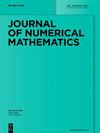对角隐式龙格-库塔格式:离散能量平衡定律和紧性
IF 4
2区 数学
Q1 MATHEMATICS
引用次数: 0
摘要
摘要研究了适合Gelfand-triple框架的抽象进化问题的对角隐式Runge-Kutta (DIRK)格式。我们引入了新的稳定性概念,非常适合于这种情况,并提供了简单的、必要的和充分的条件来验证DIRK方案在我们的意义上和在bochner型范数下是稳定的。我们使用几种流行的DIRK方案来说明满足结构稳定性要求的情况和不满足结构稳定性要求的情况。此外,在一些温和的结构条件下,我们可以保证离散解族相对于时间离散的紧性。本文章由计算机程序翻译,如有差异,请以英文原文为准。
Diagonally implicit Runge-Kutta schemes: Discrete energy-balance laws and compactness properties
Abstract We study diagonally implicit Runge-Kutta (DIRK) schemes when applied to abstract evolution problems that fit into the Gelfand-triple framework. We introduce novel stability notions that are well-suited to this setting and provide simple, necessary and sufficient, conditions to verify that a DIRK scheme is stable in our sense and in Bochner-type norms. We use several popular DIRK schemes in order to illustrate cases that satisfy the required structural stability properties and cases that do not. In addition, under some mild structural conditions on the problem we can guarantee compactness of families of discrete solutions with respect to time discretization.
求助全文
通过发布文献求助,成功后即可免费获取论文全文。
去求助
来源期刊
CiteScore
5.90
自引率
3.30%
发文量
17
审稿时长
>12 weeks
期刊介绍:
The Journal of Numerical Mathematics (formerly East-West Journal of Numerical Mathematics) contains high-quality papers featuring contemporary research in all areas of Numerical Mathematics. This includes the development, analysis, and implementation of new and innovative methods in Numerical Linear Algebra, Numerical Analysis, Optimal Control/Optimization, and Scientific Computing. The journal will also publish applications-oriented papers with significant mathematical content in computational fluid dynamics and other areas of computational engineering, finance, and life sciences.

 求助内容:
求助内容: 应助结果提醒方式:
应助结果提醒方式:


